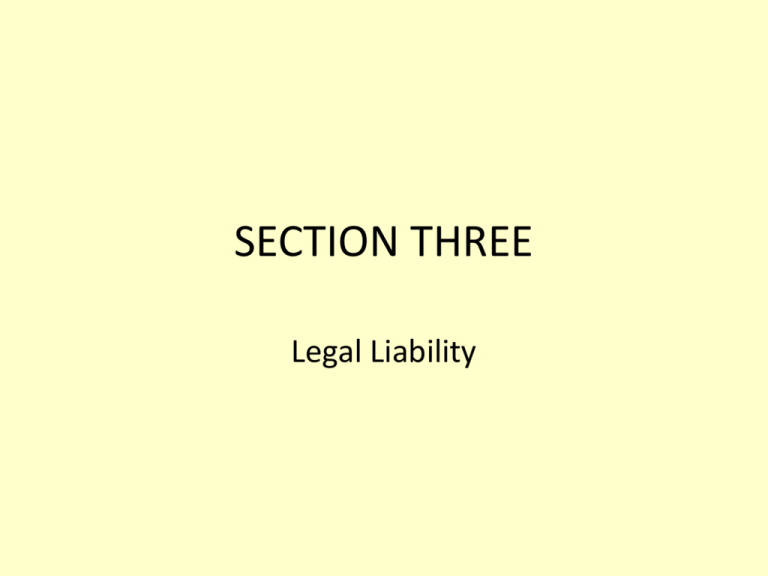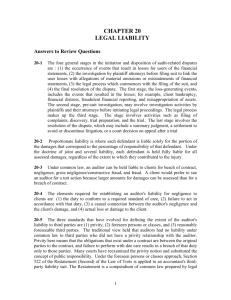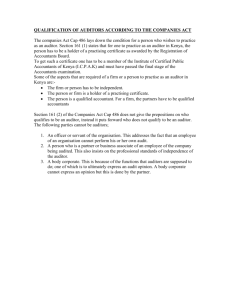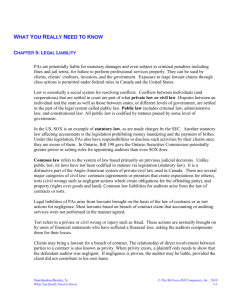Information Systems
advertisement

SECTION THREE Legal Liability The Auditor’s Legal Liability • A litigious society • The cost to accounting firms • Awareness • Common law • Statute law Common Law vs Statute Law • The main difference • Common Law • clients • third parties • Statute Law Common Law Liability to Clients • Clients suit against an auditor, two categories • Client action can be based upon • breach of contract • tort • Is an auditor infallible? • Errors of judgement and negligence » innocence » error of judgement » negligence » gross negligence » fraud » constructive fraud Burden of Proof • Auditor accepted duty of care • Auditor breached duty of care • Client suffered a loss • Close causal relationship between 2 & 3 Defenses Used by the Auditor • Reasonable care and skill • Clients own negligence • No causal relationship 1136 Tenants v Max Rothenberg and Company (1967) • Cooperative apartments • F/S unaudited • Tenants sued firm for failure to find fraud • MR engaged to prepare F/S, tax returns, and a schedule for real estate taxes • Manager of management firm was embezzling funds • Two main issues: 1. 2. • Some auditing procedures were done • A worksheet was entitled » “Missing Invoices” Fund of Funds Limited v Arthur Andersen (1982) • FF paid King Resources $90M for oil & gas reserves • FF did not determine this higher profit until much later on • Said that AA had a duty to inform FF or resign • Properties supposed to be sold at arms length • AA auditor of FF and KR • AA noticed that sales at much higher profit than to other KR customers • Not reported to FF • AA defense was based on the “rules of conduct” Consolidata Services Inc. v Alexander Grant & Co. (1981) • CS a payroll company • Meeting between CS and AG showed that CS was insolvent • AG did tax work • also recommended CS payroll services to its clients • AG requested CS to notify CS customers • CS refused • AG informed CS that it would inform all AG customers • CS requested a 10 day wait • AG called its customers • CS sued AG for negligence and breach of contract H.E. Kane Agencies v. Coopers & Lybrand (1983) • Kane an agent for a national airline • Airline supposed to be promptly paid for tickets • Kane’s son extended credit on these sales. Delayed recording of sales • Airline caught on and Kane had to pay $250,000 for outstanding sales • Kane sued C&L. Said they should have done a year end cutoff of sales • C&L claimed they were not obligated to advise on business matters • Judge found C&L failed to detect the extension • But also that Kane had lack of supervision and willful concealment of unreported sales • Thus company contributed to its own loss Liability to Third Parties • Most frequent common law action • Typical circumstances • Third party then claims • Third party must prove same elements previously seen Third Party Damage Recovery • Gross negligence or fraud is straightforward • Negligence is more complex – until late 1960’s • only to clients • privity of contract Ultramares Corp. vs Touche, Niven & Co. (1931) • Ultramares, a finance company is 3rd. party • Auditor’s client, Fred Stern borrowed money from Ult. • Ult. relied upon Fred Sterns audited F/S • TN did not know this • Ult. Said that F/S were false and TN were negligent • Stern declared bankruptcy • Court said that F/S were not prepared for the express benefit of Ultramares • Thus TN not negligent Ultramares Doctrine • If an auditor’s conduct is more serious than a mere error of judgement, but not gross negligence or fraud, a third-party who is identified or qualifies as a primary third-party beneficiary may recover, but other third parties may not. • Ordinary negligence? • Privity of contract? Hedley Byrne & Co. v Heller & Partners Ltd. (1963) • House of Lords • HB received a credit rating from HP, the banker of the client • HB thus incurred a loss • Client in serious financial difficulty and subsequently could not pay • HB sued HP to recover • HP had issued a disclaimer for responsibility • Thus House ruled in HPs favour • House indicated that there could be liability if giver of advice knew or ought to have known that the receiver was going to rely on it • No privity, but a special relationship established Gordon T. Haig v Ralph L. Bamford et al.(1976) • GH approached manager of SEDCO for investment advice. SEDCO had already advanced funds to Scholler Furniture • SF needed more funds. Their auditor was RB • GH advanced funds based on the F/S • SF foundered • GH invested more funds • SF wound up their operations • GH sued RB for negligence • Supreme Court found that accountants were negligent • SF told RB they need audited F/S for their bank and an unknown investor • From Haig v. Bamford • Tests for duty of care to third parties 1 Forseeability of the use of the F/S and client reliance thereon. 2 Actual knowledge of the limited class of F/S user. 3 Actual knowledge of specific plaintiff using the F/S Toromont Industrial Holdings Ltd. v Thorne et al. (1975) • TIH wanted to acquire all shares of CIMCO for cash plus TIH shares • Thorne were the auditors of CIMCO • A TIH partner talked to a Thorne partner about this • Thus Thorne had prior knowledge • TIH sued Thorne for negligence. Said F/S did not present fairly • Court said F/S did present fairly but that Thorne were negligent due to poor audit procedures • Showed that TIH did have right of action against Thorne since Thorne knew TIH would rely on F/S • But case was dismissed because no damages were suffered Albert Dupuis v Pan American Mines et al. (1979) • AD bought shares of PA • Prospectus for a share offering. Thorne expressed clean opinion on F/S. • Stock was delisted. AD sued to recover loss. • AD was able to prove reliance on F/S • Court ruled that auditors were negligent. They owed a duty of care to prospective investors • Appears to broaden auditor’s liability • But not heard at Supreme Court, and did not refer to Haig v Bamford Dixon v Deacon,Morgan,McEwan, Easson (1989) • BC case • Dixon purchased $1.2 M in shares of National Business Systems Inc. • Fraudulent overstatement of sales. Not disclosed in F/S • Dixon sued auditors to recover loss • Market price went from $12.89 to $3.50 • Court ruled there was no proximity of relationship between investor and shareholder • Case dismissed Caparo Industries PLC v Dickman (1990) • House of Lords • Caparo relied upon accounts prepared by Dickman. Prepared for management purposes • Accounts negligently prepared by Dickman • House ruled that Caparo could not recover either as an investor or shareholder • Engagement letter showed auditor had a duty of care • But no specific duty of care to investors or shareholders • Auditors only liable to third parties if third parties used them for the purpose for which they were prepared McGauley et al v British Columbia (1990) • Depositors in a failed Co-op advanced the claim • Claimed that auditors should have warned about the lack of deposit insurance • Court ruled that there was no duty owed • If any depositor had shown specific reliance, there may have been a duty of care • Purpose of F/S was not to warn depositors about financial affairs of the Co-op Surrey Credit Union v Wilson (1990) • SCU invested $7.5M in a Northland Bank debenture • Northland bank subsequently collapsed • SCU sued auditors for negligent preparation of F/S • Auditors said the F/S were for Northland Bank, not for investors • But the court noted that there had been a prospectus issued • Court said SCU was entitled to rely on F/S. A duty of care was therefore owed • Thus auditors knew that debentures could not be issued without audited F/S Kripps v Touche Ross et al (1990) • Investors purchased Victoria Mortgage Corporation debentures based on an issued prospectus • VMC Collapsed and investors sued auditors for negligent preparation of F/S • Court concluded that auditors should have been aware of the class of persons investing • Prospectus needed audited F/S • This and previous cases Show that the purpose of the F/S is crucial to the outcome • Thus duty of care was owed Hercules Management v Ernst & Young (1997) • HM and others sued EY • Plaintiff argued that • Case dismissed at two Manitoba courts • Supreme Court • General principle Summary of Liability to Third Parties • If statements are prepared for a specific purpose and this is known to the auditors • duty of care is owed • If F/S prepared to assist shareholders in assessing management of company • If F/S included in a prospectus Criminal Liability • Very often State v. Defendant • Means of punishing and deterring • Fraud is typical example • F/S known to be materially misstated or false United States v Simon (1969) loans to Continental Vending Valley Commercial Corp (an affiliate of CV) X Y X Pledged Y as collateral Secured by common stock of Roth • To finance stock market TAs Mr. Roth, President of Continental Vending • • Y loans to Not respected in the community Had served a jail term • The court decision said that the footnote regarding this transaction was presented in an obscure manner • Convicted two partners of fraud • Key question from this case » can auditors defend themselves by demonstrating compliance with GAAP United States v. Weiner (1978) or The Equity Funding Case • The F/S were manipulated by a massive overstatement of net income and assets • Finding against auditors was largely circumstantial • But the magnitude was so large and over a long period of time • auditors knew of the fraud and performed acts in furtherance of the fraud • This case illustrates the risk when auditors perform sloppy work • Best defense is to perform a thorough audit ESM Government Securities v Alexander Grant & Co. (1986) • Losses from securities trades were concealed by intercompany transactions • Losses > $300M • AG partner convicted of being party to the concealment Summary of Sources and Types of Liability • Liability to clients – under contract law for • ordinary negligence • gross negligence • fraud • Liability to third parties – under common law for • fraud • gross negligence • ordinary negligence (limited class) Liability for Unaudited Statements • Due care • How? • By adherence to standards • Material error? • Engagement letter • 1136 Tenants v Max Rothenberg Preventing Legal Actions • Areas of high audit risk • Errors and irregularities • Supervision • Initial engagements • Ethical behaviour Corporate Governance • Definition • Use of corporate governance structure • Monitoring • Parties to corporate governance • All parties have interest in effective corporate performance • Principles – Rights and equitable treatment of shareholders – Interests of other stakeholders – Role and responsibilities of the board – Integrity and ethical behaviour – Disclosure and transparency • Mechanisms and controls – Internal corporate governance controls – External corporate governance controls • Systemic problems of corporate governance – Supply of accounting information – Demand for information – Monitoring costs • Role of the accountant – Accountants and auditors – Accounting firm area of concern – Enron collapse • Regulation – Self-Regulation – Rules versus principles – Enforcement • Attention to corporate governance – Issues are receiving greater attention – High-profile cases – Widely studied Sarbanes –Oxley Act 2002 Also known as the ‘Public Company Accounting Reform and Investor Protection Act’ (in the Senate) and ‘Corporate and Auditing Accounting and Responsibility Act’ (in the house). The bill was enacted as a reaction to a number of major corporate and accounting scandals including those affecting Enron, Tyco International, Adelphia, Peregrine Systems and WorldCom. These scandals, which cost investors billions of dollars when the share prices of affected companies collapsed, shock public confidence in the nation's securities’ markets. It does not apply to privately held companies. It created a new, quasi-public agency, the Public Company Accounting Oversight Board, or PCAOB, charged with overseeing, regulating, inspecting and disciplining accounting firms in their roles as auditors of public companies. Has played a useful role in restoring public confidence in the nation’s capital markets by, among other things, strengthening corporate accounting controls. Canada – Bill 198 An Ontario legislative bill effective April 7, 2003, which provides for regulation of securities issued in the province of Ontario. To protect investors by improving the accuracy and reliability of corporate disclosures. Bill 198 amends Part XXIII of the Ontario Securities Act. In June 2003, all Canadian Securities Commissions (except BC) issued three regulations for public comment designed to build on Bill 198. In Canada we now have the Canadian Public Accountability Board (CPAB) incorporated in 2003 under the Canada Corporation Act. The mission: To contribute to the public confidence in the integrity of financial reporting issuers in Canada by promoting high quality, independent auditing. Problem 1: The public accounting firm of Andre, Mathieu & Paquette (AMP) was expanding very rapidly. Consequently, it hired several junior accountants, including Jim Small. The partners of the firm eventually became dissatisfied with Small’s production and warned him that they would be forced to discharge him unless his output increased significantly. At that time, Small was engaged in audits of several clients. He decided that to avoid being fired, he would reduce or omit entirely some of the standard auditing procedures listed in audit programs prepared by the partners. One of the public accounting firm’s clients, Newell Corporation, was in serious financial difficulty and had adjusted several of the accounts being audited by Small to appear financially sound. Small prepared fictitious working papers in his home at night to support purported completion of auditing procedures assigned to him, although he in fact did not examine the adjusting entries. The public accounting firm rendered an unqualified opinion on Newell's financial statements, which were grossly misstated. Several creditors, relying on the audited financial statements, subsequently extended large sums of money to Newell Corporation. Required: Would the public accounting firm be liable to the creditors who extended the money because of their reliance on the erroneous financial statements if Newell Corporation should fail to pay them? Explain. Problem 2: Jan Sharpe recently joined the public accounting firm of Spark, Watts, and Wilcox. She quickly established a reputation for thoroughness and steadfast dedication to following prescribed auditing procedures to the letter. On her third audit for the firm, Sharpe examined the underling documentation of 200 disbursements as a test of purchasing, receiving, vouchers payable, and cash disbursement procedures. In the process, she found 12 disbursements for the purchase of materials with no receiving reports in the documentation. She noted the exceptions in her working papers and called them to the attention of the incharge accountant. Relying on prior experience with the client, the in-charge accountant disregarded Sharpe’s comments, and nothing further was done about the exceptions. Subsequently, it was learned that one of the client’s purchasing agents and a member of its accounting department were engaged in a fraudulent scheme whereby they diverted the receipt of materials to a public warehouse while sending the invoices to the client. When the client discovered the fraud, the conspirators had obtained approximately $70,000, $50,000 of which was recovered after the completion of the audit. Required: Discuss the legal implications and liabilities to Spark, Watts, and Wilcox as a result of the facts just described. Problem 3: In confirming accounts receivable on December 31, 2001, the auditor found 15 discrepancies between the customer’s records and the recorded amounts in the subsidiary ledger. A copy of all confirmations that had exceptions was turned over to the company controller to investigate the reasons for the difference. He, in turn, had the bookkeeper perform the analysis. The bookkeeper analyzed each exception, determined its cause, and prepared elaborate working papers explaining each difference. Most of the differences in the bookkeeper’s report indicated that the errors were caused by timing differences in the client's and customer’s records. The auditor reviewed the working paper and concluded that there were no material exceptions in accounts receivable. Two years subsequent to the audit, it was determined that the bookkeeper had stolen thousands of dollars in the previous three years by taking cash and overstating accounts receivable. In a lawsuit by the client against the public accountant, an examination of the auditor’s December 31, 2001, accounts receivable working papers, which were subpoenaed by the court, indicated that one of the explanations in the bookkeeper’s analysis of the exceptions was fictitious. The analysis stated the error was caused by a sales allowance granted to the customer for defective merchandise the day before the end of the year. The difference was actually caused by the bookkeeper’s theft. Required: a. What are the legal issues involved in this situation? What should the auditor use as a defence in the event that she is sued? b. What was the public accountant’s deficiency in conducting the audit of accounts receivable? Problem 4: In 1998, the Board of Directors of Lively Plays Inc. fired George Drewerson, the co-founder and another senior management representative of the company claiming that they had engaged in fraudulent financial activities and had defrauded the company of $4 million. Payley and Karson, Chartered Accountants have been the auditors of Lively Plays Inc. for many years, and have also been the personal tax advisers of Mr. Drewerson during that time. Lively Plays Inc. engaged personnel from another office of Payley and Karson to conduct a forensic audit (a special investigation of the fraud). Mr. Drewerson obtained a court injunction delaying the release of the report on the grounds that Payley and Karson owed hi a fiduciary duty. Thus, Mr. Drewerson should have had the right to review the special report before it was released to determine whether any confidential information should be released. Required: a. Describe the role of Payley and Karson, and discuss the apparent conflict on interest in this situation. b. If Mr. Dewerson were found to be guilty of fraud, and had declared the income from the fraud on his income tax return, what would be the potential liability of Payley and Karson? Problem 5: Shen and Vetzel, a public accounting firm, were the auditors of South-Western Development, Inc., a real estate company that owned several shopping centres in south-western Ontario. It was South-Western’s practice to let each shopping centre manager negotiate that centre’s leases; they felt that such an arrangement resulted in much better leases because the local person did the negotiating. Two of the centres managers were killed in a plane accident returning home from a company meeting at the head office in Windsor. In both cases, the new managers appointed to take their places discovered kickback schemes in operation; the manager had negotiated lower rents than normal in return for kickbacks from the tenants. South-Western brought in a new public accounting firm, Jasper & Co., to investigate the extent of the fraud at those two locations and the possibility of similar frauds at other centres. Jasper & Co. completed their investigation and found four locations were involved quite independently of each other and that the total loss over five years was over $1,000,000. South-Western sued Shen & Vetzel for negligence for $1,000,000 plus interest. Required: What defense would Shen & Vetzel use? What would they have to prove?





